Whale Oil Lamp Version
-
- He's No Regular Joe Maritime Reporter, Mar 2004 #30
Joe Farcus has been in the ship design discipline of architecture for more than 28 years, starting from the refitting of old tonnage and leading up to being involved in the design of six different prototype cruise ships.
Here he shares with MR some of his thoughts on Cruise Ship Interior Design.
How do you start the design process?
In this sense I am a traditionalist. My belief is that people are booking cruises for the same basic reason they did 25 or more years ago. In one way or another those who are doing so are buying into the concept of the romance inherent with the sea. For those of us who are not sailors, being at sea is a most pleasant change of physical point of view. The view from a ship is all horizon, with occasional terra firma drifting by. The stars are brighter at night than in the city.
The floor moves! The service provided by the crew is at a high level seldom found at hotels. What a fantastic set of ground rules to begin a design. So the idea in designing in such an environment is to not do anything that takes away from these great advantages over hotels. Keep the design ship-like in some way is my guiding principle.
At the beginning of a new project, I try and put myself in the position of the guest who will sail aboard her. I ask: "What do I want to see and experience on this ship?" My answer is "Something that does not take away fromthis romance which 1 want to be a part of." The trick,of course, is to give form to that ideal which does not produce a negative effect on the desire.
What have been the biggest changes in the industry?
The level of sophistication: expected & delivered. Using movies as an analogy.
the special effects that one experienced in seeing the original Star Wars movie pales in comparison to a action movie of today. Yet the acting from 20 or even more years ago is still just as valid (and some say better) than that of today. Such is the case with cruise ship design and Entertainment Architecture.
I see the architectural solution to increased sophistication as mainly a technical one. It involves responding to the trends or better yet creating the trends by judicious analyzing of what has occurred and judging how that can be improved. Creating sophistication is very much a team creative process. It also crystallizes another personal view of mine. The cruise lines signs my contracts and pays the fees, but the passengers are the real clients. Satisfying their needs first is the best way to serve the owners. As a result we are always formally and informally reviewing every aspect of the passenger's cruise experience in order to achieve the highest level of sophistication possible. We try and anticipate their needs before they do in order to deliver carefree enjoyment.
A cruise ship takes years to build and is designed to operate for decades ...
How do you keep design relevant?
Now sophistication also applies to pure decorative design as well. When I am designing interiors for these vessels I am never trying to follow what's in fashion in architectural or interior design today. Indeed in order to achieve a personal and artistic expression it is of utmost importance to create independent of fashion. Fashion is for today.
Tomorrow is for another fashion.
FASHION IS ABOUT NEW'. WHILE DESIGN IS ABOUT BETTER.' Architecture has to be as timeless as possible to be attractive and practical.
Practicality is an important aspect as it relates to economy & even though it hurts to think this way as a designer, it is a fact of life just as important as IMO.
Achieving design sophistication & artistic expression is largely a matter of experience & tenacity. It certainly requires personal faith for it often requires leaving what has been safe & accepted, & delving into the unknown & what if? The first step in creating the interior design for a ship is the conceiving of the story, which I call the Central Idea. For me this a point of logic to build the various diverse designs around. It's both loose & strong at the same time. The strength is that all of the designs will relate to each other in some way. The looseness allows me to design the diversity, which I feel is a very important part of cruise ship design.
Diversity as mentioned is the master criteria in fleshing out the Central Idea.
I think this is also of utmost importance in designing a cruise ship. This is for several reasons not the least of which is the diversity of the passengers onboard.
On the ships I design passengers come for all backgrounds, countries, & just about every other demographic that you can think of. Therefore it seems to me that this diversity should be realized in the designs How do you balance your design with naval architecture and shipbuilding capabilities?
Advances in shipbuilding technology have mainly had a balancing effect on the rising cost of ship construction, which is due in this case to the market sophistication demands, safety issues and the cost which they create. At the end of the day, if the ship costs too much, then the passage price will raise to a point where the market will turn thin. Unfortunately, the design effect of this curtails creativity and design revolution.
In every project that I have been involved with, the initial most daring naval architecture creativity is always compromised in the final form of the ship. But this is a fact of life which slows revolution into evolution.
What will the Cruise Ship of the Future Be?
Questions about the future are best answered by the past, as it is the only guide post to which one may rely upon to give any insight into predicting what may come. 'Should,' is the key word to this future. The cost of ships today does not allow for mistakes in basic planning, therefore the ships which will come to be will be evolutionary rather than revolutionary.
I'm sure that owners would be happier believing that they are being shown a new design which should be built, rather than one which could be built.
What is the market that will steer the future?
Again, the past is the breeding ground in my opinion. If the past tells us anything, it tells us that the market wants more. If we look at the matriarchal ships which created cruising as we know it today, it is clear that what they have offered the market then, is the whale oil lamp version of the halogen light today.
Yet some of these veterans are still showing guests a good time, which demonstrates to me that the initial concepts which began the phenomenal growth of cruising are still pertinent today. What has happened is that those concepts have become sophisticated, from safety items, to decoration materials, to new concepts of ship designs, to ways to cook a thousand chickens better: it is dramatic. In my mind, the personal face of the market has always been a diverse group of people. This has played itself out in my work whereby I have very consciously and deliberately set out to create diverse and varied environments with and within all of the ships I have designed.
-
 )
March 2024 - Marine Technology Reporter page: 42
)
March 2024 - Marine Technology Reporter page: 42NEW TECH OCEANOLOGY INTERNATIONAL 2024 Image courtesy Greg Trauthwein Image courtesy BIRNS MacArtney launches the new ultra-compact ø12.7 mm SubConn Nano connector. Innovative connectivity built on 45 years of ? eld-proven and market-trusted design. Image courtesy MacArtney Birns celebrated its 70th
-
 )
March 2024 - Marine Technology Reporter page: 39
)
March 2024 - Marine Technology Reporter page: 39Photo courtesy Global Ocean Design Figure 7 A 35Ah AGM lead-acid battery is tested using the West Mountain Radio CBA to show the effect of simply ? lling the battery voids with mineral oil as a compensating ? uid. The CBA is programmed to cut-off at a voltage of 10.50v. The top line (red) shows the
-
 )
March 2024 - Marine Technology Reporter page: 38
)
March 2024 - Marine Technology Reporter page: 38LANDER LAB #10 Photo courtesy West Mountain Radio Photo courtesy of Clarios/AutoBatteries.com Figure 6 The West Mountain Radio Computerized Battery Analyzer (CBA V) attaches to a Figure 5 laptop by a USB-B cable, and to a battery by Powerpole® Connectors. Exploded view of an AGM lead-acid battery.
-
 )
March 2024 - Marine Technology Reporter page: 36
)
March 2024 - Marine Technology Reporter page: 36LANDER LAB #10 Of special interest for marine applications, LiPo batteries are Shipping any kind of lithium battery can be a challenge, and offered in a “pouch” design, with a soft, ? at body. The pouch IATA regs vary with the batteries inside or outside an instru- is vacuum-sealed, with all voids ?
-
 )
March 2024 - Marine Technology Reporter page: 35
)
March 2024 - Marine Technology Reporter page: 35Figure 1 A self-righting vehicle design with buoyancy high and weight low, WHOI’s SeaBED AUV captures the attention of a pair of curious Antarctic penguins as it is deployed from the British research vessel James Clark Ross. Vehicle designers allowed for temperature reduction of battery capacity. Recharge
-
 )
March 2024 - Marine Technology Reporter page: 33
)
March 2024 - Marine Technology Reporter page: 33regulated industry in the world.” How- ever, commercial success depends on many factors, not least a predictable OPEX. Over the past four years, SMD has worked with Oil States Industries to calculate cost per tonne ? gures for prospective customers. Patania II uses jet water pumps to Oil States’
-
 )
March 2024 - Marine Technology Reporter page: 18
)
March 2024 - Marine Technology Reporter page: 18TECH FEATURE IMR There are also weaknesses in terms of accuracy because of FiGS Operations and Bene? ts signal noise and the ability to detect small ? eld gradients. In Conventional approaches to evaluating cathodic protection this process there is a risk that possible issues like coating (CP)
-
 )
March 2024 - Marine Technology Reporter page: 4
)
March 2024 - Marine Technology Reporter page: 4Editorial NIWA-Nippon Foundation TESMaP/ Rebekah Parsons-King www.marinetechnologynews.com ast month marked the resounding NEW YORK 118 E. 25th St., New York, NY 10010 return of Oceanology Interna- Tel: (212) 477-6700; Fax: (212) 254-6271 tional in London, perennially one Lof the world’s most important
-
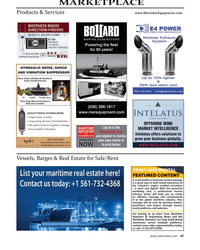 )
April 2024 - Maritime Reporter and Engineering News page: 47
)
April 2024 - Maritime Reporter and Engineering News page: 47MARKETPLACE Products & Services www.MaritimeEquipment.com Powering the fleet for 60 years! HYDRAULIC NOISE, SHOCK AND VIBRATION SUPPRESSOR Noise, Shock, VibraO on & PulsaO on in Quiet, Smooth Flow Out Oil Bladder Nitrogen (blue) Manufactured by MER
-
 )
April 2024 - Maritime Reporter and Engineering News page: 41
)
April 2024 - Maritime Reporter and Engineering News page: 41Nautel provides innovative, industry-leading solutions speci? cally designed for use in harsh maritime environments: • GMDSS/NAVTEX/NAVDAT coastal surveillance and transmission systems • Offshore NDB non-directional radio beacon systems for oil platform, support vessel & wind farm applications
-
 )
April 2024 - Maritime Reporter and Engineering News page: 38
)
April 2024 - Maritime Reporter and Engineering News page: 38Tech Files Latest Products, Systems and Ship Designs Zero-Emission Mooring Service of a Tanker Consulmar achieved a milestone by executing what it calls ing boat Castalia, which operates on full electric propulsion. the world's ? rst zero-emissions mooring service for a tanker. Equipped with two 150 kW
-
 )
April 2024 - Maritime Reporter and Engineering News page: 35
)
April 2024 - Maritime Reporter and Engineering News page: 35SIMULATION e have a close relationship with tech- Realism is prized beyond immersive, photo-realistic visu- nology, evidenced by, for example, als, and providers are introducing increasingly accurate func- the phones we are estimated to un- tionality. FORCE Technology’s upcoming DEN-Mark2 math- lock around
-
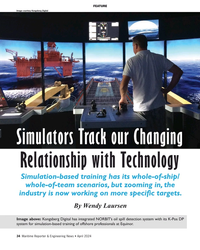 )
April 2024 - Maritime Reporter and Engineering News page: 34
)
April 2024 - Maritime Reporter and Engineering News page: 34FEATURE Image courtesy Kongsberg Digital Simulators Track our Changing Relationship with Technology Simulation-based training has its whole-of-ship/ whole-of-team scenarios, but zooming in, the industry is now working on more speci? c targets. By Wendy Laursen Image above: Kongsberg Digital has integrated
-
 )
April 2024 - Maritime Reporter and Engineering News page: 32
)
April 2024 - Maritime Reporter and Engineering News page: 32FEATURE A closeup of a blade installation process taken via drone. A blade handling system is apparent (in yellow). Images courtesy of Mammoet requirement for the development of these cranes, particularly ling area. This would result in a major time and fuel saving. in ? oating offshore wind,” says
-
 )
April 2024 - Maritime Reporter and Engineering News page: 25
)
April 2024 - Maritime Reporter and Engineering News page: 25RADM PHILIP SOBECK, MILITARY SEALIFT COMMAND Photo by Brian Suriani USN Military Sealift Command From a global supply chain perspective, What makes MSC so vital to the we’ve learned a lot about dealing with Navy’s ? eet and our military disruptions. COVID delivered a big forces around the world? wake-up
-
 )
April 2024 - Maritime Reporter and Engineering News page: 21
)
April 2024 - Maritime Reporter and Engineering News page: 21ROB LANGFORD, VP, GLOBAL OFFSHORE WIND ob Langford has worked in the offshore industry ABS. “We are growing and evolving our services across all for more than three decades, ‘cutting his teeth’ offshore infrastructure along with our continued support to the in a UK design ? rm working in the North Sea
-
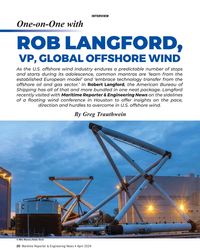 )
April 2024 - Maritime Reporter and Engineering News page: 20
)
April 2024 - Maritime Reporter and Engineering News page: 20INTERVIEW One-on-One with ROB LANGFORD, VP, GLOBAL OFFSHORE WIND As the U.S. offshore wind industry endures a predictable number of stops and starts during its adolescence, common mantras are ‘learn from the established European model’ and ‘embrace technology transfer from the offshore oil and gas
-
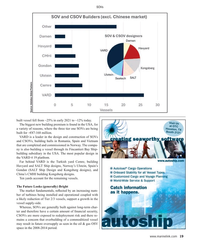 )
April 2024 - Maritime Reporter and Engineering News page: 19
)
April 2024 - Maritime Reporter and Engineering News page: 19SOVs Source: Intelatus Global Partners built vessel fell from ~25% in early 2021 to ~12% today. Visit Us The biggest new building premium is found in the USA, for at OTC Houston, TX a variety of reasons, where the three tier one SOVs are being Booth 2121 built for ~€87-168 million. VARD is a leader in
-
 )
April 2024 - Maritime Reporter and Engineering News page: 18
)
April 2024 - Maritime Reporter and Engineering News page: 18MARKETS & gas activity returns, we anticipate that supply of the vessels The Question of Emissions to offshore wind projects will reduce, driving demand for ad- Given that SOVs and CSOVs operate in a segment target- ditional CSOVs. ing reduced emissions, and many operate in the North Eu- Outside of China
-
 )
April 2024 - Maritime Reporter and Engineering News page: 17
)
April 2024 - Maritime Reporter and Engineering News page: 17SOVs China, we do not look at demand for SOVs/CSOVs as having a linear rela- tionship to the number of wind farms or turbines installed. We look to see where a large number of wind turbines are concentrated in relatively close proximity, generally in a very large wind farm or in a project cluster
-
 )
April 2024 - Maritime Reporter and Engineering News page: 16
)
April 2024 - Maritime Reporter and Engineering News page: 16MARKETS SOVs – Analyzing Current, Future Demand Drivers By Philip Lewis, Director of Research, Intelatus © Björn Wylezich/AdobeStock t a high-level, there are three solutions to transferring Lower day rate CTVs are often used for daily transfer of technicians from shore bases to offshore wind farms
-
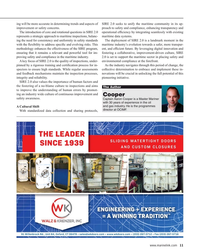 )
April 2024 - Maritime Reporter and Engineering News page: 11
)
April 2024 - Maritime Reporter and Engineering News page: 11ing will be more accurate in determining trends and aspects of SIRE 2.0 seeks to unify the maritime community in its ap- improvement or safety concerns. proach to safety and compliance, enhancing transparency and The introduction of core and rotational questions in SIRE 2.0 operational ef? ciency by
-
 )
April 2024 - Maritime Reporter and Engineering News page: 10
)
April 2024 - Maritime Reporter and Engineering News page: 10Maritime Safety © Roman/AdobeStock SIRE 2.0: Navigating the New Horizon of Maritime Safety By Captain Aaron Cooper, Programs Director, OCIMF he maritime industry is on the cusp of a signi? cant preparing vessel operators and vessel assurance teams for the transformation with the launch of the Ship
-
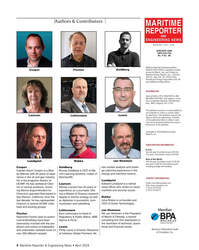 )
April 2024 - Maritime Reporter and Engineering News page: 4
)
April 2024 - Maritime Reporter and Engineering News page: 4Authors & Contributors MARITIME REPORTER AND ENGINEERING NEWS M A R I N E L I N K . C O M ISSN-0025-3448 USPS-016-750 No. 4 Vol. 86 Maritime Reporter/Engineering News (ISSN # 0025-3448) is published monthly Cooper Fischer Goldberg except for March, July, and October by Maritime Activity Reports, Inc.
